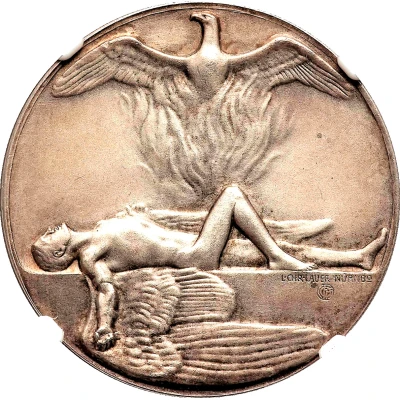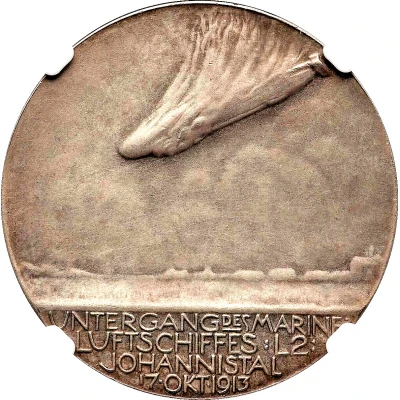Reverse
Artful depiction of the fire-engulfed airship.
Comment
LZ 18 was first flown on 6 September at Friedrichshafen, and following a number of trial flights was flown to Johannisthal on 20 September for naval acceptance trial to begin, the flight of about 700 km (438 mi) taking twelve hours.[2] The ship's tenth flight was to be an altitude trial and was scheduled for 17 October.[3] The airship was removed from its shed in the morning but takeoff was delayed because one of the engines would not start. The delay of two hours while the engine was repaired allowed the morning sun to heat the hydrogen, causing it to expand. This caused the airship to ascend rapidly to 610 m (2,000 ft), when horrified observers on the ground saw a flame leap out of the forward engine car, causing the explosion of some of the gasbags. Halfway to the ground there was a second explosion, and as the wreckage hit the ground further explosions followed as the fuel tanks ignited. Three survivors were pulled from the blazing wreckage, but two died shortly afterwards and the third died that night in hospital. In all 28 men died, including Pietzker, and the new chief of the Admiralty Aviation Department, Korvettenkapitän Behnisch, the successor to Korvettenkapitän Metzing who had been killed in the L 1 on 9 September. The accident was agreed to have been caused by the rapid ascent leading to venting of hydrogen through the relief valves, which in Zeppelins of the period were placed at the bottom of the bags, without vent trunks to convey any hydrogen let off to the top of the ship. Some of the vented gas was then sucked into the forward engine car, where it was ignited, the fire then spreading to the gasbags.






